Why Your Home’s Air Quality Matters More Than You Think

Indoor air can be as polluted as outdoor air, posing risks to health since most people spend 90% of their time indoors. This guide explores Indoor Air Quality (IAQ), sources of indoor pollutants, their health effects, and practical steps to improve the air in your home.
What is Indoor Air Quality?
Indoor Air Quality (IAQ) refers to the quality of air within and around buildings and structures, especially as it relates to the health and comfort of occupants. Good IAQ means the air is clean, clear, and free from pollutants that can cause irritation or illness. Poor IAQ, on the other hand, contains harmful gases or particles that can lead to a range of health issues.
Many factors affect IAQ, including ventilation, humidity levels, and the presence of various pollutants. The concentration of these pollutants can often be two to five times higher indoors than outdoors, making it a significant environmental health risk.
Common Sources of Indoor Air Pollution
To improve your home’s air quality, you first need to identify the potential sources of pollution. Many everyday items and activities can release harmful substances into the air you breathe.
Volatile Organic Compounds (VOCs)
Volatile Organic Compounds are gases emitted from certain solids or liquids. VOCs are widespread and found in many household products. Common sources include:
- Paints, varnishes, and wood preservatives
- Cleaning supplies, disinfectants, and air fresheners
- Furniture made from pressed wood
- Carpets and building materials
- Printers and craft supplies
These compounds can cause eye, nose, and throat irritation, as well as headaches and nausea. Long-term exposure to high concentrations of some VOCs may lead to more severe health problems.
Biological Pollutants
These are living organisms or their byproducts that can contaminate the air. They thrive in damp or humid environments. Key biological pollutants include:
- Mold and Mildew: These fungi grow in moist areas like bathrooms, basements, and kitchens. They release spores into the air, which can trigger allergic reactions and respiratory issues.
- Dust Mites: These microscopic creatures live in bedding, upholstered furniture, and carpets. Their waste products are a common allergen.
- Pollen: Pollen from outdoor plants can easily enter your home through open windows and doors or on clothing, affecting those with seasonal allergies.
- Pet Dander: Skin flakes from cats, dogs, and other furry pets can cause allergic reactions in sensitive individuals.
See also: How to Extend the Life of Aging Infrastructure: A Modern Guide
Combustion Pollutants
Combustion appliances that are not properly vented can release harmful gases into your home. These include carbon monoxide (CO) and nitrogen dioxide (NO2). Sources of these pollutants can be:
- Gas stoves and ovens
- Fireplaces and wood-burning stoves
- Water heaters and furnaces
- Tobacco smoke
Carbon monoxide is particularly dangerous because it is colorless and odorless. High levels can be fatal, making CO detectors an essential safety device in any home.
The Health Impacts of Poor Indoor Air Quality
Exposure to indoor air pollutants can affect your health in various ways, with effects ranging from mild and temporary to severe and long-lasting.
Short-Term Effects
Some health effects can appear shortly after a single exposure or repeated exposures to a pollutant. These are often treatable and may go away once the source of pollution is eliminated. Common short-term effects include:
- Irritation of the eyes, nose, and throat
- Headaches
- Dizziness and fatigue
- Worsening of asthma and allergy symptoms
These symptoms can sometimes be mistaken for a cold or other viral illness, making it difficult to pinpoint poor air quality as the cause.
Long-Term Effects
Continuous exposure to poor IAQ over months or years can lead to more serious health conditions. The long-term effects may not be noticeable until significant time has passed. These can include:
- Respiratory diseases like asthma and bronchitis
- Heart disease
- Cancer
- Damage to the central nervous system, liver, and kidneys
The severity of these effects can depend on the type of pollutant, its concentration, and an individual’s overall health and sensitivity.
How to Improve Your Home’s Air Quality
The good news is that you have a great deal of control over the air quality in your home. By taking a few proactive steps, you can significantly reduce indoor pollutants and create a healthier living environment.
1. Increase Ventilation
Proper ventilation is one of the most effective ways to improve IAQ. It involves bringing fresh outdoor air into your home to dilute and remove indoor pollutants.
- Open Windows and Doors: Whenever weather permits, open windows and doors for a few minutes each day to let fresh air circulate.
- Use Exhaust Fans: Run exhaust fans in your kitchen when cooking and in your bathroom during and after showers to remove moisture and combustion pollutants.
- Consider a Ventilation System: For more advanced control, a mechanical ventilation system, like a heat recovery ventilator (HRV), can provide a continuous supply of fresh, filtered air.
2. Control Pollutant Sources
Minimizing pollutants at their source is a key strategy.
- Choose Low-VOC Products: When painting or buying new furniture, look for products labeled “low-VOC” or “zero-VOC.”
- Store Chemicals Properly: Store paints, solvents, and other chemicals in a well-ventilated area, preferably outside the main living space.
- Maintain Appliances: Ensure all combustion appliances are professionally installed, maintained, and properly vented to the outdoors.
3. Keep Your Home Clean
Regular cleaning can dramatically reduce the amount of dust, dander, and other allergens in your home.
- Vacuum Regularly: Use a vacuum cleaner with a HEPA filter to capture small particles. Pay special attention to carpets, rugs, and upholstered furniture.
- Dust with a Damp Cloth: A damp cloth traps dust instead of just moving it around.
- Wash Bedding Frequently: Wash sheets, pillowcases, and blankets in hot water weekly to kill dust mites.
4. Use Air Purifiers
Portable air purifiers or whole-house systems can help remove airborne particles. Look for models with HEPA filters, which are effective at capturing tiny pollutants like dust, pollen, and pet dander.
The Role of Your HVAC System
Your home’s heating, ventilation, and air conditioning (HVAC) system is central to maintaining good IAQ. It circulates air throughout your home and can filter out pollutants if maintained correctly.
- Change Filters Regularly: HVAC filters trap dust, pollen, and other airborne particles. Check your filter every month and replace it at least every three months. A clogged filter not only reduces air quality but also makes your system work harder, increasing energy costs.
- Schedule Professional Maintenance: Have your HVAC system professionally inspected and serviced at least once a year. A technician can clean the coils and ducts, check for issues, and perform necessary tasks like AC repairs in Cottonwood Heights to ensure your system runs efficiently and cleanly.
- Control Humidity: Your HVAC system helps regulate humidity levels. High humidity promotes the growth of mold and mildew, so ensure your system is effectively dehumidifying the air, especially during warmer months.
Conclusion
Good indoor air quality is essential for your family’s health. Simple actions like reducing pollution sources, opening windows, and maintaining your HVAC system can create a healthier, more comfortable home.





